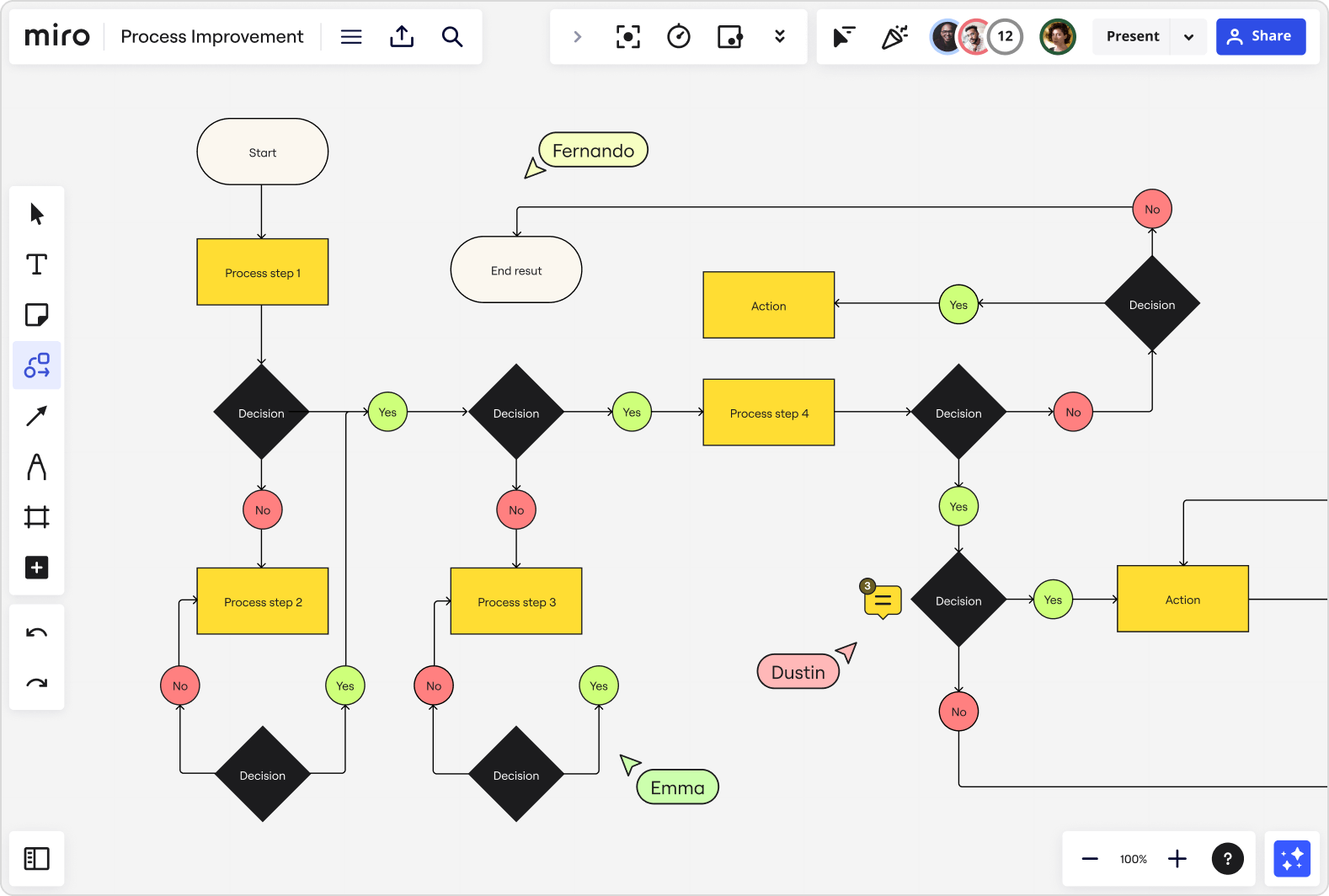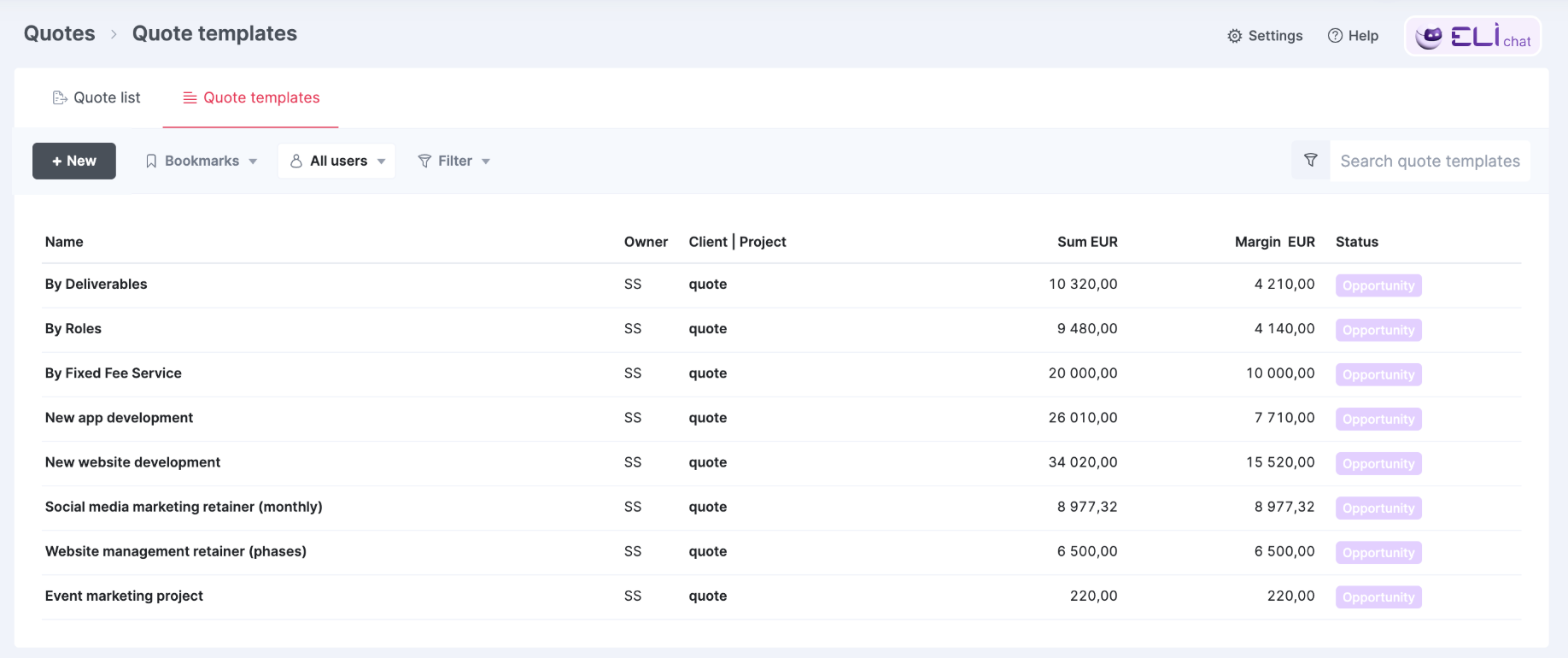We spoke with seasoned operators—Meredith Fennessy Witts, Rachel Pereyra, Ashley Madden, Kristen Kelly, and Sarah Still—to learn how they systemize businesses by improving processes.
Their advice is clear:
Start small, focus on one high-impact workflow, and build momentum with improvements your team will actually use.
Here’s the step-by-step playbook. With expert-backed tactics you can put into practice today.
Step 1: Find your firm’s biggest headache
Start by identifying the most dysfunctional process that’s worth investing time and energy to fix.
Focus on something that creates a pain point for your team and affects your bottom line.
Here are signs that a process deserves your attention:
- It’s messy or inconsistent. Everyone does it differently, using disconnected tools or manual tasks.
- It creates delays, rework, or confusion. Deliverables get stuck in limbo while teams wait for approval—or they often need to be redone.
- It impacts revenue, delivery, or client satisfaction. More than just an inconvenience, it negatively affects your firm’s profitability.
Meredith Fennessy Witts, founder of Le Chéile, calls this “operational detective work.” She explains:
Often, operational inefficiencies show up first in the numbers: low margins, scope creep, or payroll that’s outpacing revenue. I look for financial patterns. Which projects are consistently running over budget? Are sales lagging because of a sales process that hasn’t evolved as the agency has scaled?
Once you’ve spotted a red flag, talk to your team.
As fractional COO Rachel Pereyra points out:
You have to talk to the team, look at the numbers, and get raw with the founder. I want to know how many hours everyone is logging, where they are feeling friction, who their favorite and least favorite clients are, what are the margins on each service line, and what’s the overall profitability.
To narrow down your focus, ask these questions:
Financial patterns:
- Which projects keep running over budget?
- Are margins thinner than expected on certain services?
- Is payroll growth outpacing revenue growth?
Team patterns:
- Where do people say they waste the most time?
- Which clients/projects create the most frustration?
- What tasks often need rework or extra approval cycles?
If the same issues show up in both the numbers and the team feedback, that’s your biggest headache—and the first process to systemize.
If you uncover multiple broken processes, use this scoring sheet to decide which to fix first. You’ll find instructions on how to use it within the sheet.

Step 2: Capture how your team actually works
Once you’ve picked a problem area, study how the work really happens.
How do employees really navigate workflows? What are their shortcuts or skipped steps?
Ashley Madden, director of operations at Ten Speed, emphasizes the value of talking with the people who use the systems you’ve developed.
I want to understand how the process functions in real life, not just on paper. Often, there’s a gap between how a process was designed and how people actually use it day to day.
It’s easy to assume you know what’s going on with your team—especially if you’ve held the same role before.
But, as a former individual contributor and manager, Ashley notes:
My past hands-on experience gives me empathy, but the real experts are the current contributors and managers. They’re in the thick of it—and the tools, challenges, and daily rhythms change all the time. Even if I used to do the job, it’s vital to listen to those doing it now.
To understand what’s going on behind the scenes:
- Check in with everyone who has a role in the process. That might include an AE/sales, a delivery lead, finance/ops.
- Ask them to go through their exact process. You want to see how your team gets the job done—shortcuts, tools, and all.
- Use software to record their process. Like Loom, which records their screen as they complete the task. Or Scribe, which documents the steps they take.
Then, ask your team to gather any shared docs and messages they use in the process.
Say you’re analyzing the cost estimating process for client projects.
On paper, a simple process might look like this:
Your AE drafts scope → delivery lead reviews estimates → finance checks rates/margin → quote approved → send to client.
But here’s what you actually observe:
- AE duplicates an old quote, tweaks hours quickly
- Uses a blended rate (no role breakdown), omits QA/PM buffer
- No delivery review before sending
- Last-minute discount added to “get it over the line”
- Result: quotes are underestimated by ~15–25%; margins shrink post-kickoff
Kristen Kelly, agency profitability consultant at Parakeeto, recommends taking the process a step further with a root cause analysis.
This involves asking ‘why?’ a number of times to take a delivery team member from describing the symptom to getting at the problem.
So why does this keep happening?
- Why are projects over budget? → Underestimated hours in the quote
- Why underestimated? → No delivery review; missing QA/PM buffer
- Why no review/buffer? → Old template + hurry to hit a proposal deadline
- Why the hurry? → Sales incentives favor speed/wins over accuracy
- Why incentives misaligned? → No governance: no required approval gate, no margin guardrails, no owner
Looking at reality moves you from the symptom (20% overruns) to a fixable process:
A quoting/estimation workflow that needs clear ownership, a mandatory delivery review, current rate cards, and built-in buffers.
Combine these observations with hard data to get the full picture—so you can rewrite the process.
Step 3: Break the process into clear tasks
After analyzing your broken process, it’s time to transform it.
To translate it into new, clear steps and repeatable tasks that can be easily assigned.
To get started, use Layla Pomper’s “What, When, Who” method:
- What: The specific task (e.g., check team availability)
- When: The timing or trigger (e.g., when scoping a potential project)
- Who: The responsible role (e.g., ops coordinator)
Here’s what a cleaned-up quoting workflow might look like:
| Task | Owner | Timing |
|---|---|---|
| Draft scope and effort estimate | Account exec | During proposal prep |
| Validate hours and buffers | Delivery lead | Before quote is finalized |
| Check rates and margin | Finance/ops | Before sending to client |
| Approve and send quote | Sales director | Same day |
Once you have the foundation in place, add in the supporting details. Kristen recommends adding relevant tools, systems, references, and files.
For quoting, that might include:
- The rate card or role-based pricing model
- A scoping checklist (e.g., don’t forget QA and PM hours)
- A margin guardrail (e.g., minimum 45% delivery margin)
And don’t just list steps. Map the hidden work
Treat mapping as a way to surface the invisible work that causes breakdowns.
Four tips for effective process mapping:
- Start and end clearly. Define the boundaries (e.g., sales opens opportunity → client signs approved quote).
- Capture every handoff. Mark where the quote moves from AE → delivery lead → finance. Handoffs are where most errors creep in.
- Document decisions and exceptions. Include rules like “Discounts >15% must be approved by sales director.”
- Validate with reality. Once mapped, run it by the people who actually do the work. Their feedback will surface missing steps and shortcuts that don’t show up on paper.
And if you’re a visual thinker, you can also draw out the new process.
I map the process as a flowchart while jotting notes or using AI to capture thoughts in real time. Cross-referencing the visual with a step-by-step helps me spot gaps—but the most important step is validating it with the people actually doing the work.
Map the workflow in a tool like Miro. Their free SOP process template makes it easy to draw out steps, handoffs, and decision points so you can see the flow end-to-end.

A mapped process isn’t just a tidy checklist. It’s a living system that makes ownership, timing, and decision rules crystal clear.
And it gives you the foundation you need to turn the quoting workflow into a proper SOP in Step 5.
Step 4: Designate a process owner
Even the smartest process improvements will fail when no one truly owns them.
There’s a major difference between assigning tasks and designating ownership:
- Task owners complete the work
- Process owners ensure a successful outcome, evolve the system, and handle issues
Without an owner, the workflow is likely to break down the moment the task owner gets too busy or shifts into a different role.
Rolling out a process is as much about people as it is about systems. I recommend identifying a process owner to champion it internally, build in space for team feedback, and show how the change improves both their daily work and the agency’s bottom line.
For example, You might assign an ops lead or finance manager to own the quoting process. They don’t draft every proposal—that’s still the AE’s task.
But they:
- Adjust the process over time when patterns of overruns reappear
- Ensure every quote includes delivery review and margin checks
- Maintain the rate card and scoping checklist
- Monitor approval steps to prevent rushed or underpriced quotes
How to pick the right owner:
- Close enough to the work to understand how the process actually runs and where it breaks down
- Senior enough to influence change and hold people accountable when steps aren’t followed
- Proactive about improvement, not just maintenance—willing to refine templates, update tools, and gather team input
- Stable in role, so ownership won’t vanish if a short-term contractor or junior employee moves on
A process without an owner is a process set up to fail. For quoting especially, ownership is what turns a rushed, error-prone workflow into a consistent, profitable system.
Step 5: Create a standard operating procedure (SOP)
Now that you’ve mapped and improved the process, the final step is to turn it into an SOP (standard operating procedure) your team will actually use.
An SOP is a short, step-by-step guide that explains how a specific task should be carried out, who is responsible, and what success looks like.
Here’s a simple, repeatable way to create SOPs that stick:
1. Start with a template
Always duplicate a pre-built template in your tool of choice (Google Docs, Confluence Notion, etc). This keeps your SOPs consistent and fast to produce.
We’ve included this SOP template to get you started.

2. Choose the right scope
SOPs are like directions: they get you from point A to point B. Keep them short and modular—covering one task, not an entire function.
Write “How to create a quote in Scoro” (single task), not “How to run sales” (too broad).
If a process feels too big, break it down (e.g., How to prepare a quote, How to send a quote for approval).
3. Assign two roles upfront
Every SOP needs two people involved:
- Subject matter expert (SME): The person with the know-how. They explain what needs to happen and why.
- Owner: The person who writes, updates, and maintains the SOP. They ensure it stays relevant over time.
These can be the same person, but they don’t have to be.
For example, for the quoting process, the SME might be a senior account exec.
The owner could be an ops lead who ensures the rate card, guardrails, and approval steps stay current.
Top Tip
New hires often make excellent Owners. Documenting a process during onboarding forces them to learn it quickly and ensures the SOP is written from a fresh perspective.
4. Define start, stop, and key steps:
Write down the trigger that kicks off the process, the last action that ends it, and the 5–8 critical steps in between. Keep steps short and outcome-based.
Example:
- Start: Client requests a proposal
- Steps: Draft scope in Scoro → Delivery lead validates hours → Ops checks margin → Sales director approves
- Stop: Quote sent to client
Ashley suggests documenting SOPs in multiple formats:
To make processes stick, I document them in multiple formats: written steps with screen recordings of the actual workflows at the top of the SOP. That way, team members can either read or watch—whatever suits their learning style.
5. Add purpose, inputs, and outputs
These fields keep the SOP focused and measurable:
- Purpose: Why this SOP exists
- Inputs: What’s required to start (e.g., rate card, scope draft, client details)
- Outputs: What success looks like (e.g., approved quote sent, margin guardrails met)
6. Fill in details quickly
Don’t over-engineer. Draft the SOP in 5–10 minutes using this shortcut:
- Record yourself doing the process with Loom
- Export the transcript
- Paste the transcript into ChatGPT with your SOP template and ask it to format the SOP for you
Copy-paste this prompt into ChatGPT along with your transcript:
Prompt
You are an operations consultant. Take the transcript below (a recording of someone walking through a workflow) and turn it into a Standard Operating Procedure (SOP) using this structure:
– Purpose: A one-line statement of why this SOP exists.
– Owner: The role responsible for maintaining this SOP.
– Start: The trigger that kicks off the process.
– Stop: The last action that marks the process as complete.
– Inputs: What’s required to begin (files, logins, approvals).
– Steps: 5–8 short, outcome-based steps.
– Outputs: What success looks like when the SOP is followed correctly.
– Notes/FAQs: Optional clarifications or edge cases.
Keep steps short, clear, and outcome-focused (e.g., “Invoice is sent to client” not “Click send”).
If something in the transcript is unclear, make your best guess and flag it with [brackets]
7. Keep it living and modular
SOPs shouldn’t be static. Encourage edits, comments, and improvements as they’re used. Store them in a tool with version history (like Notion or Confluence).
Instead of one massive “Sales SOP,” create modular ones like How to draft a quote, How to approve a discount, How to send a proposal.
That way, if you update a tool (e.g., switch from Excel to Scoro’s quoting module), you only need to revise one SOP, not 30 pages.
Check out this episode of The Handbook to learn more about documenting and embedding best practices:
Step 6: Roll out your new SOP
Set your team up for success by helping them adopt the new workflows with minimal friction. Show them the value right away.
Clearly explain:
- What changed: What’s different about the process
- Why it matters: How it benefits them and the business
- Where to find the new SOP: Include a link to the Notion page or Google doc
The best way to roll out new SOPs depends on the size of your organization.
- For small teams, a Slack message can work. For example: ““Hey all, we’ve updated our quoting process to include delivery review before sending proposals. This should reduce budget overruns and make projects easier to manage. Here’s the new workflow [Loom link] and SOP [link]. Starting Monday, please use this version.”
- For a mid-size team, announce the new SOP at a weekly standup. Provide a cheat sheet that team members can reference with a summary of key changes and a link to the SOP.
- For larger organizations, pilot the updated process with one department first. Once that team has successfully adopted it, roll out the SOP to the rest of the organization.
After announcing your process improvements, offer training sessions.
In my past life as an agency operator, I found a team rollout in an all-agency meeting to be a useful starting place for visibility, to make the ‘why’ clear and to showcase support from leadership. From there, small group or 1:1 trainings are where the learning really takes place.
Rachel Pereyra recommends a “gentle project management” approach:
Have a team training, meet with anyone struggling one on one, and leave space for feedback and iteration.
Follow up with team members who seem confused or resistant, ask what’s not working for them, and make updates based on their feedback rather than just pushing compliance.
Then, after the initial rollout is complete, keep the conversation open.
As Ashley Madden reminds us:
Make people feel comfortable flagging problems or asking for changes. Ultimately, it’s about fostering a culture where process improvement is ongoing, not a one-off project. And where leadership is about listening, not just leading.
Step 7: Review outcomes and improve your process
As Kristen notes, “Processes are living, iterative, and need to be validated in their effectiveness.”
Pick one or two simple metrics for each process so you can see whether the SOP is working.
For quoting/estimation, that could be:
- % of fixed-price projects delivered within budget
- Average margin per project
In Scoro, you can track these with real-time dashboards that show metrics like delivery margin, labor costs, and average billable rate (ABR) per project.

Review these KPIs on a monthly basis. Look for improvements over time to understand whether your team is following the new process.
Numbers only tell part of the story. Sarah Still, founder of Vivid Impact Partners, cautions:
Metrics can be helpful, but in my opinion, they’re overrated. Engaged humans who care about the quality and timeliness of work will spot the need for improvement much faster.
For qualitative insights:
- Use feedback forms or Slack polls. Ask team members how the process is working for them.
- Hold a quarterly retrospective. Review both month-over-month metrics and the bigger picture. Assess what’s working and celebrate wins.
If feedback is overwhelmingly positive, Sarah recommends “building the task flows into project management platforms as templates.”
For example, with Scoro, you can create quote templates.
Templates let you bake in deliverables, roles, and margins for standard projects—so every new proposal starts from a consistent, approved baseline.
You can even enable dynamic rates, so your templates always pull the latest unit prices and labor costs without manual updates.

If metrics and feedback make it clear that the new process isn’t working, however, revisit your SOP and tweak it as needed.
And keep an eye out for certain company changes—clear signals to revisit your processes:
- Role transitions: As Sarah points out: “Another key trigger (proactive) is when the team is growing and suddenly a person who wore five hats is now handing off a hat to a separate person. That immediately triggers a process revamp.”
- Revenue milestones: “We see founders hitting friction points when they scale past certain financial and team thresholds,” Meredith explains. “For example, when surpassing $1 million, clients often see bloated overhead, profit margins slipping, or leads stalling in the pipeline.”
- Sustained growth: “The biggest cue is scale,” Ashley says. “If the team, client list, or workload grows by a big percent, I proactively revisit our processes. I also keep a close eye on productivity metrics and client satisfaction.
Automate and systemize with Scoro
Remember: process improvement is about business outcomes, not bureaucracy.
As Kristen puts it, “At the end of the day, systemizing processes isn’t about rigid control—it’s about building clarity, creating visibility, and facilitating scalable margins.”
And you don’t need to systemize everything manually.
Scoro helps professional service firms automate and streamline core processes—from quoting and project delivery to resource planning and billing.






